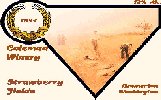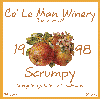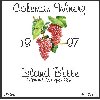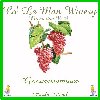
 This was the first wine that I tried, turned out not to bad, but, things get better with age and it is still young. We'll see, so much wine, so little time.
This was the first wine that I tried, turned out not to bad, but, things get better with age and it is still young. We'll see, so much wine, so little time. This is the second wine that I tried, turned out a little better. I have discovered that this one has quite a bite to it, probably because of my early transfer methods(see below). It isn't bad, just needs t obe drank really cold. We'll see, I have learned a lot since this batch, may need to make another batch to compare. We'll see, lots of different wines to make.
This is the second wine that I tried, turned out a little better. I have discovered that this one has quite a bite to it, probably because of my early transfer methods(see below). It isn't bad, just needs t obe drank really cold. We'll see, I have learned a lot since this batch, may need to make another batch to compare. We'll see, lots of different wines to make. This is my first project that I used grapes in. I used untested grapes. If looked good, but, upon tasting it(January 1999), found it to be very watery. C'est la vie. So much for my homemade recipes. I guess I will end up dumping this batch and learning one more thing for the future.
This is my first project that I used grapes in. I used untested grapes. If looked good, but, upon tasting it(January 1999), found it to be very watery. C'est la vie. So much for my homemade recipes. I guess I will end up dumping this batch and learning one more thing for the future. I finished my batch of Scrumpy here a few months ago(August 1998). It is a coarse cider wine. I have been told that it is very good and that you will never have enough on hand when you start drinking it. I tried the Scrumpy in April 1999, not too bad, It is getting better in the bite category, but, still needs more work. I think I am getting down to adjusting the acid levels(which I have been very bad about, guess I am learning my lesson now).
I finished my batch of Scrumpy here a few months ago(August 1998). It is a coarse cider wine. I have been told that it is very good and that you will never have enough on hand when you start drinking it. I tried the Scrumpy in April 1999, not too bad, It is getting better in the bite category, but, still needs more work. I think I am getting down to adjusting the acid levels(which I have been very bad about, guess I am learning my lesson now). I have also made a second batch of Mead. This one has only one word to describe it, YES!!!!!! I finally got a really good wine. This is very smooth and tastes just as good as the $20 bottle stuff that I buy at a winery in Oregon(Nehalem Bay Winery), great place just south of Tillimook Oregon at the corner of Highways 101 and 53) This is much better than my first. I guess I got the acid levels right.
I have also made a second batch of Mead. This one has only one word to describe it, YES!!!!!! I finally got a really good wine. This is very smooth and tastes just as good as the $20 bottle stuff that I buy at a winery in Oregon(Nehalem Bay Winery), great place just south of Tillimook Oregon at the corner of Highways 101 and 53) This is much better than my first. I guess I got the acid levels right.


Wine basics(beginning):
Reds: 22% sugar(SG=1.090), 6.5 g/lit of acid.Whites: 21% sugar(SG=1.085), 7.5 g/lit of acid.
Fruits: 21% sugar(SG=1.085), 6 g/lit of acid.
High acid = sour and harsh taste
Low acid = bitter, medicinal, flat taste.
Concentrates:
Whites: 21% sugar(SG=1.085), 5 g/lit of acid.Reds: 22% sugar(SG=1.090), 4 g/lit of acid.
Frozen concentrates: 21% sugar(SG=1.085), 5 g/lit of acid.
Wine basics(end):
Reds: 5.5-6.5 g/lit of acidWhites: 6.0-8.0 g/lit of acid.
Fruits: 6.0-8.0 g/lit of acid.
Fruit:
1 lug of grapes is 35 pounds, which makes 1 gallon of first run wine and 1 gallon of second run wine.1 ounce of Elderflowers per 5 gallons, adds Riesling-like bouquet to white wines.
1 ounce of banana flakes(powder)/gallon, adds body without adding flavor to aperitif and dessert wines.
20-24 pounds of blackberries makes 5 gallons.
28 pounds of apples makes 5 gallons, Gravenstiens and Spartans are highly recommended.
15 pounds of peaches with 1 quart of white grape concentrate makes 5 gallons.(Needs yeast nutrient)
12 pounds of bananas with the juice of 4 medium oranges makes 5 gallons.
28 pounds of pears(Bartletts) makes 5 gallons.
15 pounds of cherries (Bings) with 1 quart of red grape concentrate(32 pounds of only cherries) makes 5 gallons.
16 pounds of strawberries with 1 quart of red grape concentrate makes 5 gallons.
15 pounds of cranberries with 1 quart of red grape concentrate makes 5 gallons.
12.5 to 15 pounds of honey makes 5 gallons of Mead.
12 pounds of blueberries with 1 quart of red grape concentrate.
Wine ingredients:
1 teaspoon liquid tannin is 2 teaspoons of powdered tannin1 Campden sulfite tablet adds 60ppm to one gallon of wine
17 ounces of sugar added to 5 gallons of wine raises SG by 0.010
Corn sugar/dextrose needs 1.2 times the amount of normal table sugar.
Honey needs 1.3 times the amount of normal table sugar.
2 quarts of water added to 5 gallons of must lowers the SG by 0.010 (10%).
1 level teaspoon of Vinacid equals 4 grams (5 ml) of acid for 5 gallons of wine/must.
When using lemons to raise acid level, use approximately twice as much lemon juice as acid.
Wine Recipes:
Click hereI have also typed up a Specific Gravity(SG) table that will help you get the desired alcohol level you want and to go from one level to another.
Yeasts-yes, they do make a differrence
The type of yeast that one uses in their wine has a big effect on what the final wine will taste like. Now one can always change the flavor of the wine slightly after it is finished by the addition of sugar(if you like your wines sweet). But, if you like your wines dry and you end up with that sweet wine, well, done is done. To make a list of which yeasts do what is nearly an impossible task as each manufacturer has their own name for their yeasts, resulting in thousands of names. If you are curious which one is for you, try a few one gallon batches(ie, make a 5 gallon batch and use 5 different yeasts-too much yeast won't hurt a wine) and see which one you like. Another way(but this leads to subjectivity at times) is to ask for a sweet wine yeast(if you like it sweet) or a champagne yeast(if you like it dry. I know at the brew store I go to, there is a yest that is actually called Champagne that will take the wine dry(no residual sugar) and the one that I like is called Curvee`(leaves the wine sweet-great for Meads). Most brew stores will have 5 or so different kinds of yeast. Ask the owner what they each do, then make a decision from there. Having an idea of what you like and don't like will help you choose a good yeast for you.
Acid determination by titration:
1. Ingredients:a. 4 oz of sodium hydroxide solution diluted to 1/5th normal strength.
b. 30+ ml burette.
c. Eye dropper.
d. Color solution.
2. Place 15 ml of must/wine in burette.
3. Add 3 or 4 drops of color solution.
4. Slowly add 4 ml of sodium hydroxide solution, then slowly add more solution until the liquid in the burette can no longer dissipate the pink color from the sodium hydroxide solution(liquid should have a light pink color to it for white wines or a greenish black for reds).
5. Take the final level in the burette and subtract 15 ml, this is the acid content of the must/wine in g/lit.
Filtration
I am playing around in this field a little bit and have found out what I am doing wrong with my first few batches. NOT TRANSFERRING ENOUGH!!!!!!! Hint to those of you trying wine for the first time. The process I'm currently using is not based on time, but, on the amount of dead yeast cells at the bottom of the fermentor. As it stands, I normally let the fruit set in the primary fermentor for about a week, stirring the fruit atleast daily. From there, I transfer it into the secondary where it sets until a nice layer of yeast forms at the bottom(~1/8 of an inch up the side), normally about 3 days. I then transfer the wine. Again I let the wine set in the secondary fermentor until I again get a nice layer of yeast at the bottom(~1/8 of an inch up the side), normally in about 4 days. By the time, most of the fermentation is complete and I add in my yeast killer. I then watch as the yeast falls out of solution, this will be noted by a layering effect in the wine. I wait until the layer falls to the bottom of the secondary. I then again transfer the wine. Again, you will see the layering effect happen in the wine, this time the wine will be much clearer than the first time. Wait for the layer to reach the bottom of the seconday, normally in 5 days. Keep transferring until your 3 months is up. Normally after the third transfer after the yeast killer has been added, you won't need to transfer any more since there will be very little dead yeast at the bottom of the secondary. This has worked very good for me and has improved the taste of my wine dramatically. I used to get what I refer to as a "cheap wine taste". This has gone away. My last batch, Christmas(blackberry-plum) was very good and I almost hate to give it away as a Christmas present. But, time will tell.
I have also gotten my labels on a wine information site called Strat's Place. Neat site and has information on things other than wine too. Check it out. Neat site.
Here is the latest site to feature my wine labels. It is a site called A.I.C.E.V. I have linked you to the portion of the page done in English. For those of you that know Italian, you can get the Italian version too. I am still waiting to see my pictures get posted there.











